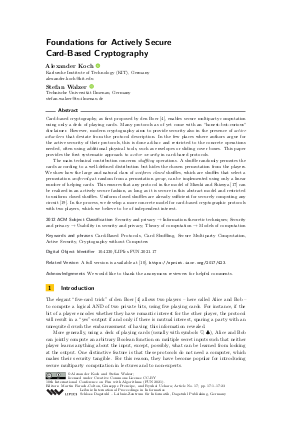@InProceedings{koch_et_al:LIPIcs.FUN.2021.17,
author = {Koch, Alexander and Walzer, Stefan},
title = {{Foundations for Actively Secure Card-Based Cryptography}},
booktitle = {10th International Conference on Fun with Algorithms (FUN 2021)},
pages = {17:1--17:23},
series = {Leibniz International Proceedings in Informatics (LIPIcs)},
ISBN = {978-3-95977-145-0},
ISSN = {1868-8969},
year = {2020},
volume = {157},
editor = {Farach-Colton, Martin and Prencipe, Giuseppe and Uehara, Ryuhei},
publisher = {Schloss Dagstuhl -- Leibniz-Zentrum f{\"u}r Informatik},
address = {Dagstuhl, Germany},
URL = {https://drops-dev.dagstuhl.de/entities/document/10.4230/LIPIcs.FUN.2021.17},
URN = {urn:nbn:de:0030-drops-127786},
doi = {10.4230/LIPIcs.FUN.2021.17},
annote = {Keywords: Card-Based Protocols, Card Shuffling, Secure Multiparty Computation, Active Security, Cryptography without Computers}
}

 Creative Commons Attribution 3.0 Unported license
Creative Commons Attribution 3.0 Unported license
